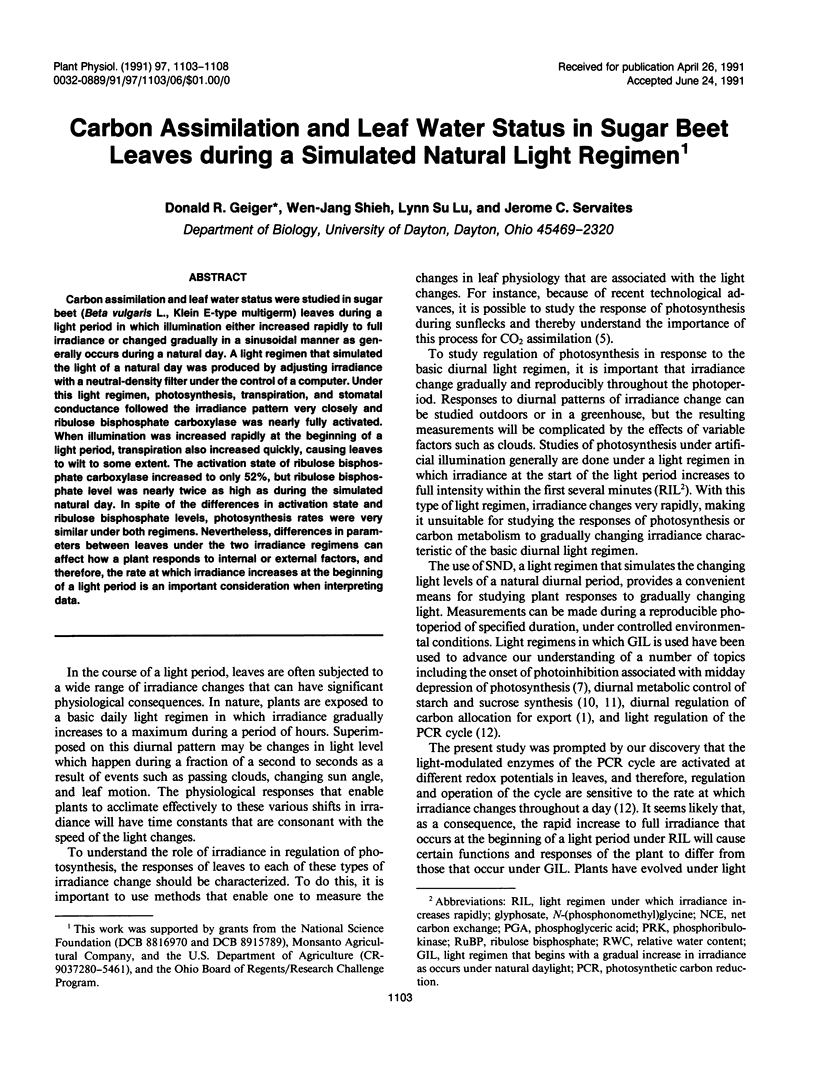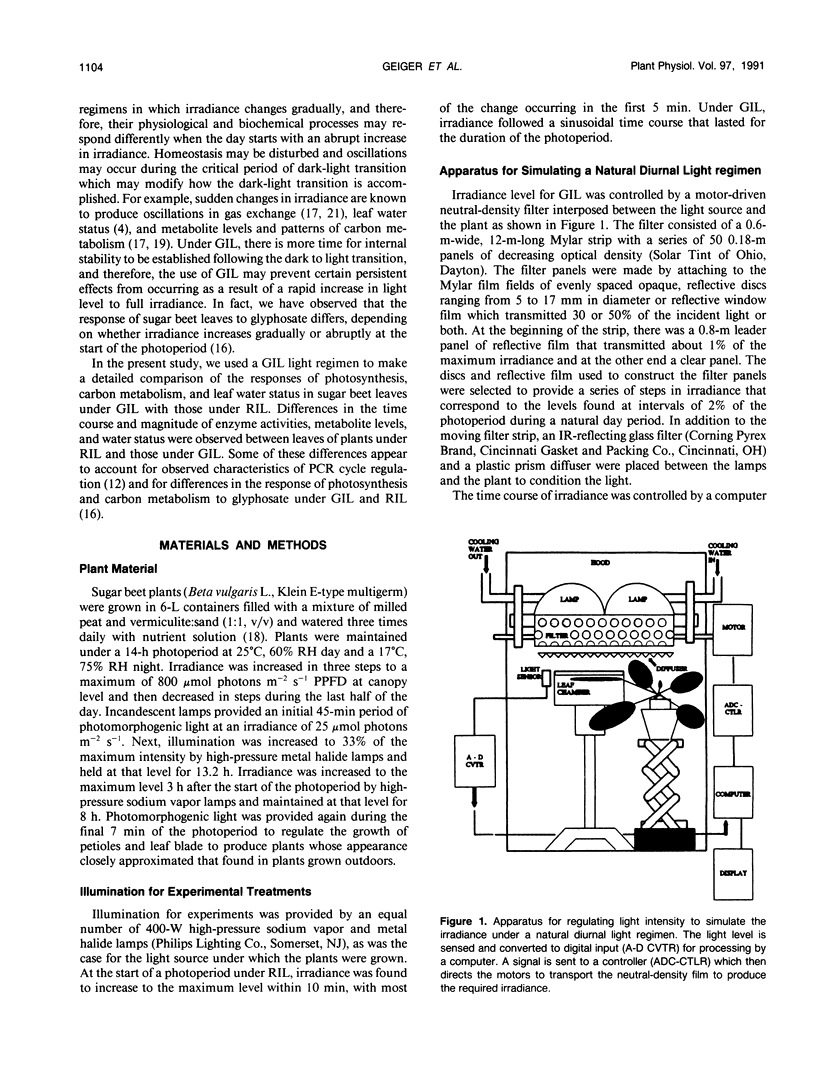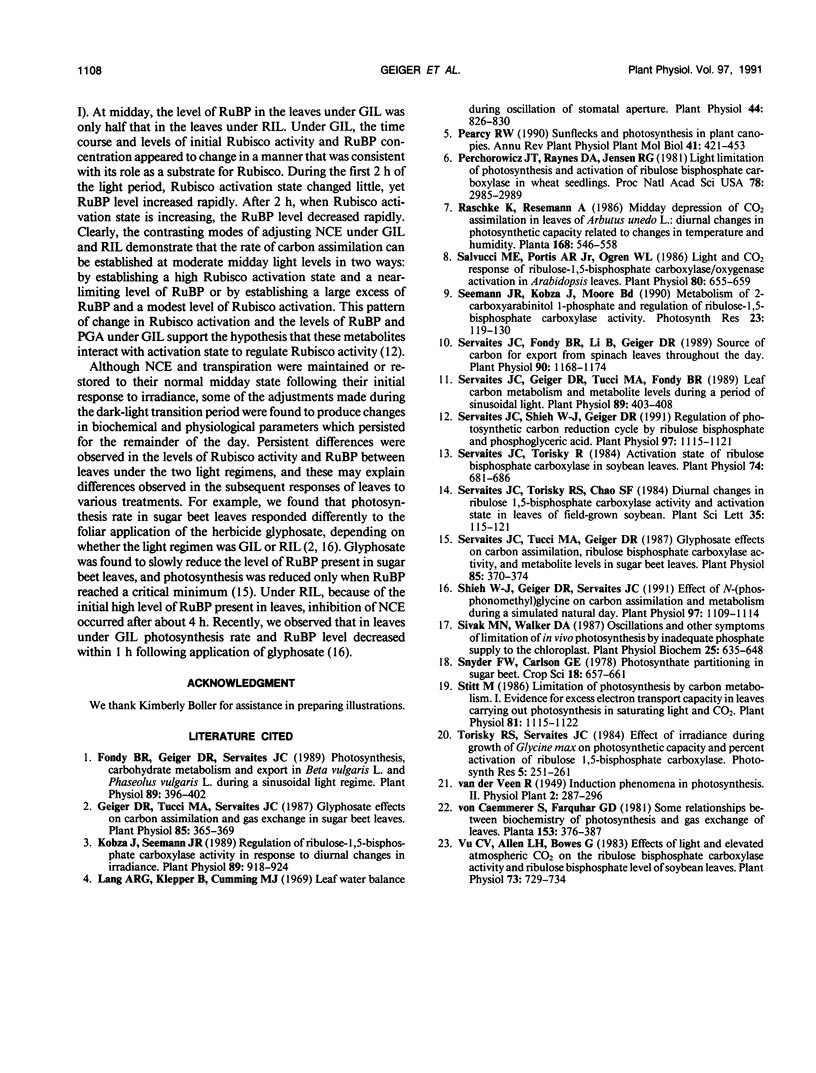Abstract
Carbon assimilation and leaf water status were studied in sugar beet (Beta vulgaris L., Klein E-type multigerm) leaves during a light period in which illumination either increased rapidly to full irradiance or changed gradually in a sinusoidal manner as generally occurs during a natural day. A light regimen that simulated the light of a natural day was produced by adjusting irradiance with a neutral-density filter under the control of a computer. Under this light regimen, photosynthesis, transpiration, and stomatal conductance followed the irradiance pattern very closely and ribulose bisphosphate carboxylase was nearly fully activated. When illumination was increased rapidly at the beginning of a light period, transpiration also increased quickly, causing leaves to wilt to some extent. The activation state of ribulose bisphosphate carboxylase increased to only 52%, but ribulose bisphosphate level was nearly twice as high as during the simulated natural day. In spite of the differences in activation state and ribulose bisphosphate levels, photosynthesis rates were very similar under both regimens. Nevertheless, differences in parameters between leaves under the two irradiance regimens can affect how a plant responds to internal or external factors, and therefore, the rate at which irradiance increases at the beginning of a light period is an important consideration when interpreting data.
Full text
PDF





Selected References
These references are in PubMed. This may not be the complete list of references from this article.
- Fondy B. R., Geiger D. R., Servaites J. C. Photosynthesis, Carbohydrate Metabolism, and Export in Beta vulgaris L. and Phaseolus vulgaris L. during Square and Sinusoidal Light Regimes. Plant Physiol. 1989 Feb;89(2):396–402. doi: 10.1104/pp.89.2.396. [DOI] [PMC free article] [PubMed] [Google Scholar]
- Geiger D. R., Tucci M. A., Serviates J. C. Glyphosate effects on carbon assimilation and gas exchange in sugar beet leaves. Plant Physiol. 1987 Oct;85(2):365–369. doi: 10.1104/pp.85.2.365. [DOI] [PMC free article] [PubMed] [Google Scholar]
- Kobza J., Seemann J. R. Regulation of ribulose-1,5-bisphosphate carboxylase activity in response to diurnal changes in irradiance. Plant Physiol. 1989 Mar;89(3):918–924. doi: 10.1104/pp.89.3.918. [DOI] [PMC free article] [PubMed] [Google Scholar]
- Lang A. R., Klepper B., Cumming M. J. Leaf water balance during oscillation of stomatal aperture. Plant Physiol. 1969 Jun;44(6):826–830. doi: 10.1104/pp.44.6.826. [DOI] [PMC free article] [PubMed] [Google Scholar]
- Perchorowicz J. T., Raynes D. A., Jensen R. G. Light limitation of photosynthesis and activation of ribulose bisphosphate carboxylase in wheat seedlings. Proc Natl Acad Sci U S A. 1981 May;78(5):2985–2989. doi: 10.1073/pnas.78.5.2985. [DOI] [PMC free article] [PubMed] [Google Scholar]
- Salvucci M. E., Portis A. R., Ogren W. L. Light and CO(2) Response of Ribulose-1,5-Bisphosphate Carboxylase/Oxygenase Activation in Arabidopsis Leaves. Plant Physiol. 1986 Mar;80(3):655–659. doi: 10.1104/pp.80.3.655. [DOI] [PMC free article] [PubMed] [Google Scholar]
- Servaites J. C., Fondy B. R., Li B., Geiger D. R. Sources of Carbon for Export from Spinach Leaves throughout the Day. Plant Physiol. 1989 Jul;90(3):1168–1174. doi: 10.1104/pp.90.3.1168. [DOI] [PMC free article] [PubMed] [Google Scholar]
- Servaites J. C., Geiger D. R., Tucci M. A., Fondy B. R. Leaf Carbon Metabolism and Metabolite Levels during a Period of Sinusoidal Light. Plant Physiol. 1989 Feb;89(2):403–408. doi: 10.1104/pp.89.2.403. [DOI] [PMC free article] [PubMed] [Google Scholar]
- Servaites J. C., Shieh W. J., Geiger D. R. Regulation of photosynthetic carbon reduction cycle by ribulose bisphosphate and phosphoglyceric Acid. Plant Physiol. 1991 Nov;97(3):1115–1121. doi: 10.1104/pp.97.3.1115. [DOI] [PMC free article] [PubMed] [Google Scholar]
- Servaites J. C., Torisky R. S. Activation state of ribulose bisphosphate carboxylase in soybean leaves. Plant Physiol. 1984 Mar;74(3):681–686. doi: 10.1104/pp.74.3.681. [DOI] [PMC free article] [PubMed] [Google Scholar]
- Servaites J. C., Tucci M. A., Geiger D. R. Glyphosate effects on carbon assimilation, ribulose bisphosphate carboxylase activity, and metabolite levels in sugar beet leaves. Plant Physiol. 1987 Oct;85(2):370–374. doi: 10.1104/pp.85.2.370. [DOI] [PMC free article] [PubMed] [Google Scholar]
- Shieh W. J., Geiger D. R., Servaites J. C. Effect of N-(Phosphonomethyl)glycine on Carbon Assimilation and Metabolism during a Simulated Natural Day. Plant Physiol. 1991 Nov;97(3):1109–1114. doi: 10.1104/pp.97.3.1109. [DOI] [PMC free article] [PubMed] [Google Scholar]
- Stitt M. Limitation of Photosynthesis by Carbon Metabolism : I. Evidence for Excess Electron Transport Capacity in Leaves Carrying Out Photosynthesis in Saturating Light and CO(2). Plant Physiol. 1986 Aug;81(4):1115–1122. doi: 10.1104/pp.81.4.1115. [DOI] [PMC free article] [PubMed] [Google Scholar]
- Vu C. V., Allen L. H., Bowes G. Effects of Light and Elevated Atmospheric CO(2) on the Ribulose Bisphosphate Carboxylase Activity and Ribulose Bisphosphate Level of Soybean Leaves. Plant Physiol. 1983 Nov;73(3):729–734. doi: 10.1104/pp.73.3.729. [DOI] [PMC free article] [PubMed] [Google Scholar]


